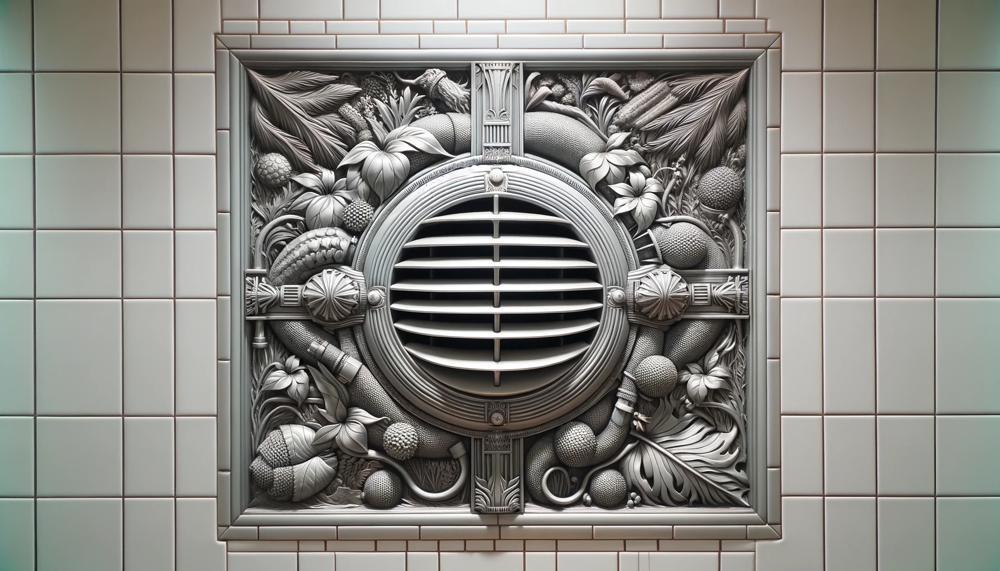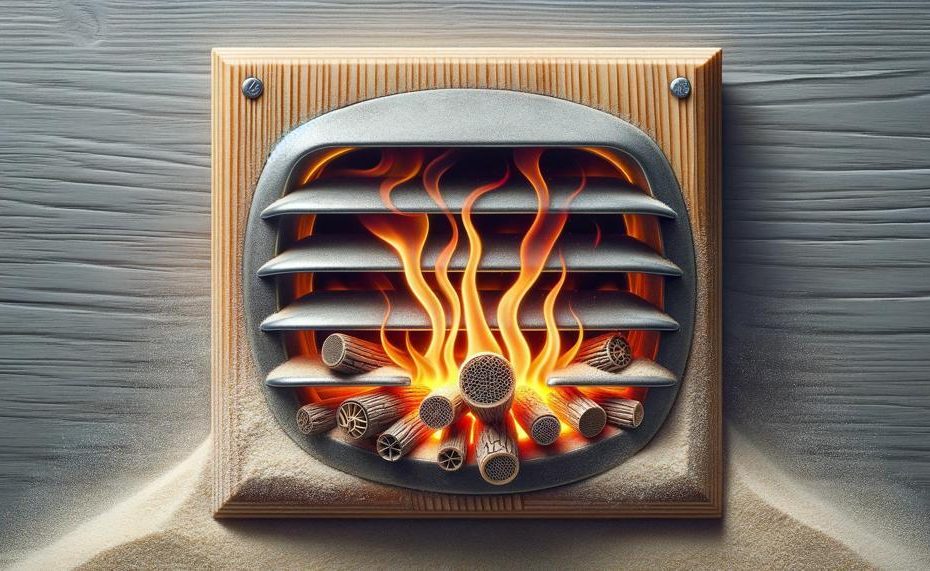Imagine this: You’re enjoying a relaxing shower, the warm water washing away the stress of the day. But suddenly, you feel a blast of heat coming through your bathroom vents. It’s not exactly the refreshing cool air you were hoping for, right? So why does this happen? why is heat coming through bathroom vent?
There are many reasons why heat might be flowing from a bathroom vent, including:
- A malfunctioning thermostat might cause heat to escape the vent when you wish to use the air conditioning.
- Dust buildup: The collection of dust, dirt, or debris in the vent pipe might impede the appropriate cooling process. Particles of flammable toilet paper might also be present in dust. If they’re not routinely removed, lint and dust might potentially catch fire.
- Open vent stuck: Warm air may enter if the vent is open.
- Electrical issues: An overvoltage supply is one kind of electrical issue that may lead to a blower fan burnout.
Now that we’ve covered the basics, let’s take a closer look at each potential cause and how you can prevent or fix them. Our expert tips and tricks will help you deal with heat coming through bathroom vents effectively and efficiently.
So keep reading for valuable insights and solutions.
Contents [show]
Dealing with Bathroom Ventilation and Building Code

The International Residential Code and the National Electric Code specify strict requirements for bathroom ventilation, ensuring adequate ventilation and safety. These requirements include venting to the outdoors, limitations on duct length and type based on fan CFM rating, and the option of using an operable window as an alternative. It is crucial to consult with the local building code for additional requirements before installation.
Insufficient ventilation in the bathroom can result in heat entering through the vent due to various factors. If the bathroom fan is not turned on or functioning properly, hot air from outside can seep through the vent and warm up the bathroom. Furthermore, if the exhaust fan is not vented to the outdoors or is exhausting into interior areas of the house, it can lead to moisture-related problems and attract unwanted pests such as ants and termites.
To prevent heat from entering through the bathroom vent, regularly checking and maintaining its functionality throughout the year is essential. This includes ensuring that the fan is turned on and properly vented to the outdoors, as well as keeping the AC running consistently to regulate the temperature inside the house.
Any damages or malfunctions with the vent or exhaust fan should be promptly addressed to avoid further issues.
Dealing with Bathroom Ventilation and Building Code:
According to both the International Residential Code (IRC) and National Electric Code (NEC), specific requirements for bathroom ventilation must be met to ensure proper ventilation and safety standards are upheld. These requirements mandate venting to the outdoors, restrictions on duct length and type based on fan CFM rating, and even allow utilization of an operable window as a substitute. Before installation, it’s vital to consult with local building codes for additional requirements.
Insufficient bathroom ventilation has serious consequences, such as heat entering through vents for various reasons. If your bathroom fan isn’t turned on or functioning properly, hot air from outside can enter through vents and heat up your bathroom. Furthermore, when exhaust fans aren’t vented to the outdoors or expel air into interior areas of the house, it causes moisture-related problems and attracts pests, like ants and termites.
To prevent heat from entering through your bathroom vent, maintaining its functionality is critical. This includes ensuring your fan is turned on and properly vented to the outdoors, in addition to keeping your AC running consistently to regulate the temperature inside your house.
Signs of Bathroom Ventilation Problems
Bathroom ventilation problems can cause heat to seep through the bathroom vent, leading to various signs that indicate underlying issues. These signs include excess moisture and condensation, foul odors, peeling paint or wallpaper, excessive humidity, loud noises, slow draining sinks or tubs, a hot and stuffy bathroom, and high energy bills.
Excess moisture and condensation in the bathroom can be a result of poor ventilation, which can lead to mold growth and damage to walls, ceilings, and floors. To address this issue, it is important to check and clean the ducts, replace damaged vent covers, and consider installing a dehumidifier in the bathroom.
Another sign of bathroom ventilation problems is foul odors lingering in the space. This can be caused by inefficient ventilation, allowing unpleasant smells to remain in the air. To combat this issue, it is recommended to clean or replace the bathroom vent cover and consider using air fresheners or essential oils to mask any odors.
Heat and moisture coming through the vent can also cause damage to walls, resulting in peeling paint or wallpaper. To prevent this from happening, repairs should be made to any damaged areas and the ducts should be checked and cleaned regularly. Additionally, damaged vent covers should be replaced.
High humidity levels in the bathroom can also indicate ventilation problems. A properly functioning vent should remove excess humidity from the air, keeping the space dry and comfortable. If this is not the case, it may be necessary to repair or replace the ventilation system.
Loud noises coming from the bathroom vent can be a sign of a malfunctioning fan or damaged ductwork. This can impact the performance of the ventilation system and lead to heat coming through the vent. In this case, it is recommended to have a professional inspect and repair the system as needed.
If water drains slowly from sinks and tubs in your bathroom, it could be due to a clogged or poorly functioning vent. This can result in heat coming through the vent and should be addressed by checking and cleaning the ducts and ensuring proper airflow.
A hot and stuffy bathroom, even when the fan is on, can indicate that the ventilation system is not working efficiently. This can cause heat to come through the vent and make the space uncomfortable. Regular maintenance and repairs may be necessary to improve ventilation.
Lastly, a malfunctioning bathroom vent can lead to higher energy bills as your HVAC system works harder to regulate the temperature in your home.
Basic Guidelines for Bath Fans
Bath fans are a great way to keep heat from entering your bathroom through its vents. Below are some simple guidelines to follow when using bath fans for this purpose:
- Choose the perfect fan: When selecting a bath fan, make sure it is the right size for your bathroom and has a low sone rating for quiet operation.
- Vent to the outdoors: The fan should be vented to the outside of the building, not into the attic or other interior spaces.
- Use rigid ducting: Flexible ducting can hinder airflow and lead to moisture buildup, so it is best to use rigid metal or PVC plastic ducting for optimal performance.
- Keep duct runs short and straight: Longer and more convoluted duct runs require larger fans for proper ventilation. Try to keep duct runs as short and straight as possible.
- Proper installation: Make sure the fan is installed correctly, with a tight seal around the vent and proper attachment to the ductwork.
- Regular maintenance: It’s important to clean and inspect the fan, ducts, and vent covers regularly to ensure they are functioning properly.
- Consider additional features: Fans with lights, variable speed control, and humidistats are convenient options for optimal ventilation.
- Seek professional help: If you have a difficult bathroom ventilation problem, it’s best to consult an experienced HVAC contractor for unconventional installations.
Options for Fixing Bathroom Ventilation Problems
When it comes to bathroom ventilation problems, there are a variety of options for addressing and preventing them. These include proper insulation, installation of a heat recovery ventilator, regular cleaning and maintenance, utilizing a timer for the bathroom fan, and ensuring that windows are properly sealed and insulated.
Insulation is key when it comes to maintaining proper bathroom ventilation. By properly insulating the walls and ceiling, you can prevent heat from coming through bathroom vents and causing issues. Additionally, installing a heat recovery ventilator can help to circulate fresh air throughout the bathroom while also removing excess humidity.
Regular cleaning and maintenance of the bathroom fan is also crucial for proper ventilation. Over time, dust and debris can build up in the fan, hindering its ability to function effectively. By routinely cleaning and maintaining the fan, you can ensure that it is working efficiently and keeping your bathroom well-ventilated.
Another helpful tip is to use a timer for the bathroom fan. This allows you to control how long the fan runs after each use, helping to remove excess moisture from the air and prevent mold and mildew growth. Additionally, ensuring proper sealing and insulation around windows can help prevent heat from entering through bathroom vents.
Conclusion
In the end, the cause of heat coming through bathroom vents can be attributed to various factors, ranging from faulty heating systems to inadequate insulation.
It is crucial to address these issues promptly in order to prevent energy wastage and potential damage to your home. Proper maintenance and installation of bathroom ventilation systems are essential in preventing heat from entering through vents.
Moreover, incorporating features such as timers and heat recovery ventilators can significantly enhance the efficiency of your bathroom fan. Remember to consult local building codes for specific requirements and seek professional assistance for unconventional installations.
By following these tips and guidelines, you can effectively tackle the issue of heat coming through bathroom vents and ensure a comfortable and well-ventilated space for your daily routines.





